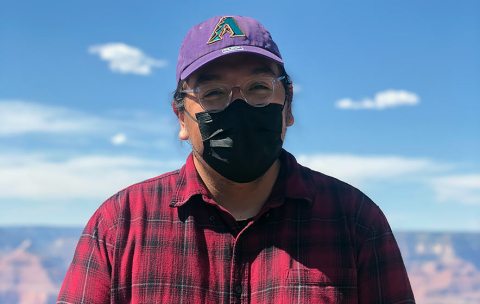Editor’s Note: This is Hanson Mike’s guest essay about a trip to the Grand Canyon East rim in Western Navajo Nation in May. The trip was to the area high above the rim top of the Little Colorado and Colorado River known as the Confluence. He is a Grand Canyon Trust intern, who works with Save the Confluence families. His work ends Aug. 5.

Courtesy of Grand Canyon Trust
Hanson Mike, a Grand Canyon Trust intern who is working with Save the Confluence families on environmental justice issues this summer.
By Hanson Mike
Before seeing the Confluence, I had only seen the Grand Canyon once, despite being raised and having lived in the Navajo Nation for years. My experience on the Desert View rim of the canyon had a touristy feel to it. I felt like I did not experience my first Grand Canyon visit to the fullest extent, though I did feel amazed at how vast and awe-inspiring the canyon was.
When I got the opportunity to revisit the Grand Canyon, I was told I would be going to the Confluence of the Colorado River and the Little Colorado River with Delores Wilson-Aguirre, a resident of the Bodaway/Gap region. I was expecting a simple visit to see into the canyon and the Confluence but what I remember the most vividly are the living conditions of the people in the Bodaway/Gap region.
Delores was an amazing guide because she told story after story about the history of the region through her memory.
When we drove through backroads to the Confluence, Delores touched on the Federal government’s Bennett Freeze of 1966, which put a 43-year development ban on 1.5 million acres, which included the Bodaway/Gap region.
Delores showed us many small structures that were used as homes. These small structures were built so that the people who originated in the Bodaway/Gap area could live in them. The Bennett Freeze prevented these people from building ideal homes and creating proper infrastructure such as water and electricity. The people had been living in challenging conditions but were resilient because, to them, this piece of land was their home.
More about Hanson Mike:
- Who: Hanson Mike
- Age:28
- Title: Grand Canyon Trusts’ Save the Confluence intern.
- Home: Diné (Navajo) from Whippoorwill, Arizona
- Education: Bachelors’ degree in Environmental Studies from Fort Lewis College.
- Interests: Enthusiastic about water security and environmental justice in Indigenous communities. Mike enjoys the outdoors and spending time with friends and family.
While witnessing the living conditions of the people who lived in this region during the Bennett Freeze, I could not help but think of the living conditions of my home. I grew up on the same Nation in Whippoorwill, Arizona. I was fortunate enough to have running water and electricity in my home.
Before my visit, I believed that everyone on the Navajo Nation had access to the same resources that I grew up with. The Bodaway/Gap region, where the Bennett Freeze took place, and my community was of different worlds. This simple truth is upsetting because I was living comfortably while the people of Bodaway/Gap had been suffering for forty-three years.
Fortunately, in 2009, then-President Barack Obama lifted the ban on development in the Bodaway/Gap region which ended the Bennett Freeze. While this was a step in the right direction for the residents of this region, there are still issues surrounding the area which include:
- outside developers seeking to use the land for their benefits,
- residents still do not have universal access to running water and electricity, and
- economic disparities in this specific region due to the Bennett Freeze.
I believe that one way to help the people who live in this region is for the Navajo Government to intervene and create infrastructure for these people. These are elderly who have strong ties to the land and should not have to leave their homes for any reason. Their right to live on their traditional lands should be honored.
My main interests during my undergrad were environmental justice and water scarcity in Indigenous communities, because I want to be able to help these communities. This visit to the Confluence and Bodaway/Gap was humbling and motivating. I got to visit a community that has lived through terrible hardship and is still resilient. Through my internship with Grand Canyon Trust, I hope to gain experience with environmental justice issues and support the Confluence in any way I can.

You must be logged in to post a comment.